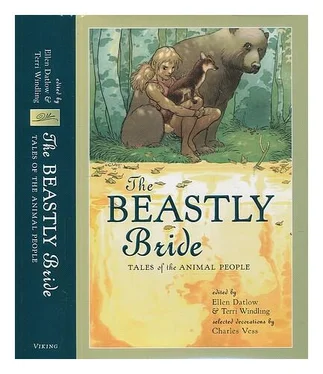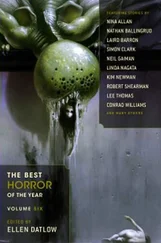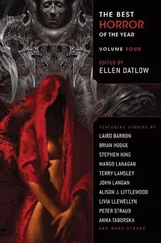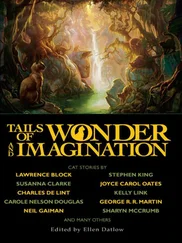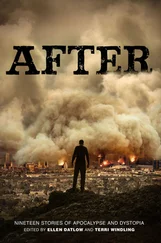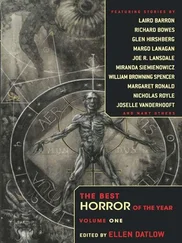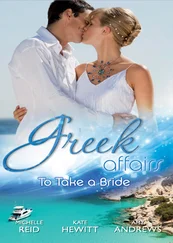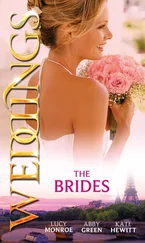Selesta said, seemingly out of nowhere, “Trebizon may have been possessed, but the way he acted with my mother is how a domestic cat reacts to a wild one.”
I realized that Joan must never have talked to her about any of this. “You’re right, honey,” I said. “That’s what it was like.”
Keeping her eyes on the road, she reached over with her left hand and pulled down the shoulder of her blouse. There was a small patch of tawny fur with a touch of black.
“How long have you had that?”
“A few years. It was just a speck, and then it grew. I knew what it was when it appeared. I shaved it at first and was afraid someone would find out. Lately I’ve let it grow.”
I watched her staring at the road, tried to see a cat shape in her head. She glanced my way, and for a moment her eyes did catch the light.
“Your mother had the same thing when I first knew her. She had to get rid of it with electrolysis. Painful stuff.”
“My mother never volunteers information about things like this. When I first got this I asked her what it meant. She mentioned her father very briefly — then told me about laser treatment.”
“But you didn’t want that.”
“I want to remember. Maybe understand something.”
We drove in silence for a while. Then Selesta said, “She was only a few years older than I am now when you met. How much did she know?”
“She had just figured out what had happened to her and to her brother, Luis. She was mad that your grandmother hadn’t been able to tell her more. But I think Ruth must have been in shock herself back then. I think your mother was, too. Maybe that’s what made them so dedicated to their work.”
“Look in that portfolio,” she said and indicated one stuck in between our seats.
It contained photos. The first few were of her grandfather, Antonio Mata. As a young man he was thin and poised. Maybe his head and face seemed a bit streamlined. But I might have been seeing that because of what I knew. He was with a group of young people in one picture at a country house in Mexico. I recognized Frida Kahlo in the crowd. In another picture, Antonio Mata in his shirtsleeves painted on a canvas.
I had seen these before. Joan had shown them to me when I first knew her. There was one of Antonio Mata and Ruth, Joan’s mother, which I remembered having seen. They made a handsome couple. Ruth wore shorts and a man’s shirt.
After her husband’s disappearance, Ruth went to Columbia Law School, married the civil rights lawyer Harry Rosen, and became a legal counsel for Amnesty International.
“Look at the next one,” Selesta said.
This one was new to me. Antonio Mata lay stretched out on the branch of a tree, looking at the camera with cat’s eyes.
“And the next.”
The picture had probably been taken at dusk on a porch. A light was on inside the house. Mata was a bit older than in the other shots. He was poised with his hands on the rails, as if he was going to leap into the gathering dark. He looked like he was trapped. I recognized the porch and the house.
“Your mother gave you these?”
“My grandmother. She took them.”
The next picture was of three children standing on the front porch of the place that Mata had called the House That Ate the World. They ranged in age from nine to maybe three. The oldest was a very serious boy who seemed to be looking at something in the distance. This, I knew was Joan’s brother, Luis. The youngest was Joan’s sister, Catherina, smiling and holding something up to the camera with both hands. Joan was right in between. She gazed up at her brother.
“I’d never seen a picture of her brother.”
“There aren’t many. They say he was very shy around strangers. A true Margay. Just look at him! Those eyes!”
“He died very young.”
“Eighteen,” she said. “Drowned in the Great South Bay a few years after his father disappeared back into Mexico. Water killed the cat. Everyone knew it was suicide.”
It’s tough when a friend you love and respect is doing something you think may be dumb and wrong. “Your mother was still torn up about that and her father’s disappearance when I first knew her,” I said, like I was pleading her case. “She really had no one to talk to.”
Selesta drove in silence. The sun was going down. I looked in her portfolio at the photos she had of Mata paintings. I found The House That Ate the World .
It’s the house in the old rural Hamptons in which Antonio Mata had lived for some years with his wife and children. In the painting it’s distended, bulging. Through open windows and doors flow furniture and phonographs, tennis shoes and radios, refrigerators and easy chairs.
Out of the house and onto the lawn in front and the meadow in back they tumble: cocktail dresses and ice buckets, strollers and overcoats, the possessions of an American household circa 1948.
“Kind of quaint compared to what’s inside an American house today,” I said.
“I don’t think it’s about materialism so much as about wariness and curiosity,” Selesta said. “And maybe fear. He’s a feline in human territory.”
“Are you afraid, honey? Like he was?”
“Sometimes I am. I think it’s good to be a little afraid sometimes.”
We drove for a while before she asked, “Was my mother ever afraid?”
“Not that I saw when she was your age. She only seemed to get scared after you were born.”
We talked a little more about her family. Brief bursts of conversation took place amid stretches of silence.
It was dark when we parked at the entrance to the driveway of the House That Ate the World. Lamps were on inside, but Joan stood on the unlighted porch and smiled as we approached.
“She can see us in the dark,” muttered Selesta. “She just shrugs when I ask her about it.”
We all embraced and Joan asked, “How was traffic?”
“No problem,” said her daughter stepping past her. “How are you?”
By night, it could almost still be the cottage of fifty years before. I caught the tang and murmur of the ocean. A few hundred yards away the tide was coming in.
Through the open windows I saw the easel in the living room with the half-finished painting. Bulbous circa-1950 American cars bore down on the viewer. Antonio Mata had disappeared without finishing it.
“A cat’s-eye view of the highway,” I murmured.
Joan looked at me and then at her daughter, who smiled. Neither said anything, but they moved down the hall to the kitchen, not touching but walking together.
When they were alone, Joan would ask her daughter what she and I had talked about on the way out here. I was glad to have given them that opening.
“Hello, Richie,” said a familiar voice behind me. I turned, and standing at the back porch door was the woman from the 1950s snapshots. Then Ruth Mata Rosen moved and that illusion disappeared. Now she walked with a cane.
Ruth had called me “Richie” the first time we met many years before. There was no reason for it that I’ve ever been able to discover. Nobody else in the world has ever used that nickname for me.
“They’re alone together?” she asked.
“In the kitchen,” I said.
“No yelling? No screams?” she asked. “I don’t necessarily hear. Especially things I don’t want to hear.”
“Quiet so far.”
“At first, with my background in negotiation, I tried to arbitrate their dispute,” said Ruth. “What I discovered was that when you spent twelve years married to the cat man and never asked some basic questions, you’re not dealing from a position of moral authority or common sense.”
“We’ve all done things like that.”
“Truly, have you ever done anything quite like that?”
Читать дальше
